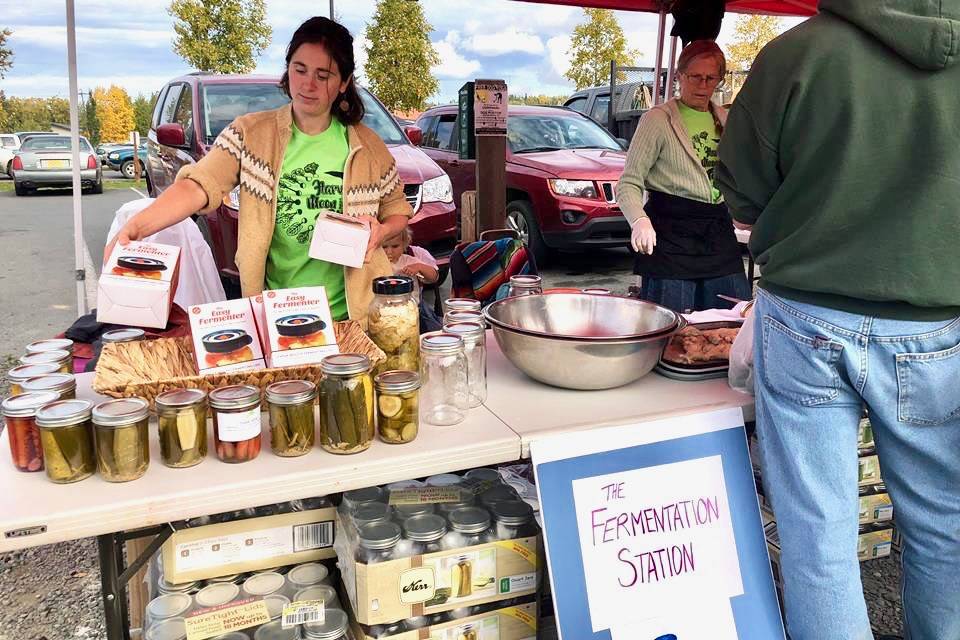Local farming and food practices will be on full display this weekend at the Harvest Moon Local Food Festival in Soldotna.
Slated for Saturday from 10 a.m. to 6 p.m. at Soldotna Creek Park, the festival aims to showcase better methods of healthy eating that also inject a healthy boost to the local economy.
According to Kenai Soil and Water Conservation District Manager Heidi Chay, the local agriculture industry is experiencing a boom. Chay referenced new statistics from the USDA Census of Agriculture showing that the sales of local foods on the Kenai Peninsula sold directly to consumers tripled from 2012 to 2017, rising from around $300,000 to $1 million in just a five-year span.
Chay said several factors were at work to spur that rise, including the peninsula adopting high-tunnel technology at locales such as the Kenai Peninsula Food Bank over the past nine years.
“The Kenai Peninsula was an early adopter of high-tunnel technology,” she said. “From small-scale gardening to small-scale market farming, the high tunnels help to lengthen the growing season.”
High tunnels are similar to greenhouses used to grow food during the winter season, except high tunnels are often laid over bare ground, getting rid of the elaborate heating and cooling systems of a typical greenhouse.
“We have space here to grow, and we have a supportive community,” Chay said.
Billed as the peninsula’s biggest local food celebration of the year, the event is hosted by the Kenai Local Food Connection, a volunteer-run organization that promotes local foods and healthy eating.
The festival lands one day after the actual harvest moon (the full moon nearest to the September equinox).
With a full schedule of live music, entertaining shows, free kid’s activities — such as making edible necklaces — a pie-baking contest, food demonstrations and a wild edible hike along the Tsalteshi Trails, Chay said the festival should feature plenty of things to do and learn about.
The festival also arrives at the end of a particularly hot and dry summer, one that saw the Swan Lake Fire burn near communities of Sterling and Cooper Landing. Among the wildfire’s effects was the delay of food deliveries to the western communities of the peninsula, including Soldotna, Kasilof and Homer.
Some deliveries took over a week to make it to store shelves.
Eliza Eller is a resident of Ionia, a nonprofit village near Kasilof that has made a living off the land with subsistence farming, and is a founding member of Kenai Local Food Connection. Eller said the wildfire effect, which may become more common with the warming climate, is a real world example of what good local farming can do for a community.
“Imagine just this community and what it would feel like if even 80 percent of our food was produced right here,” Eller said. “Just imagine how different it would be. It makes it more real, and you realize that depending on this big huge machine that’s been dependable for the last 50 years or so, is now threatened by these natural disasters.”
Eller touts herself as a home gardener, cook and teacher, and said the Harvest Moon Local Food Festival is a perfect way to show that investing in the local food market has long-term benefits.
“Everybody eats, and what they eat and how they eat shapes our culture,” Eller said. “It shapes the town, shapes the people hugely. When we start to eat foods locally grown and produced by people who live here, our neighbors, we start to create community around food. We start to nourish our bodies more completely with more nutrients and delicious food.”
One of the biggest draws of the festival is the nearly 50 food vendors who have grown, harvested or produced food in Alaska, including those that have produced health products made from locally grown or harvested ingredients. Food trucks featuring local ingredients and educational booths really add to the purpose of the festival, Chay said.
The event will also see the return of the popular fermentation station, which Chay said was a big hit last year. The fermentation station will have volunteers on hand to accept fresh produce that will be chopped, jarred and sealed for the consumer to take home and let ferment for a specified amount of time.
“One of the goals is to have people walk away with the confidence to take home veggies and preserve them for the winter,” Chay said. “It’s kind of a live cooking show.”

